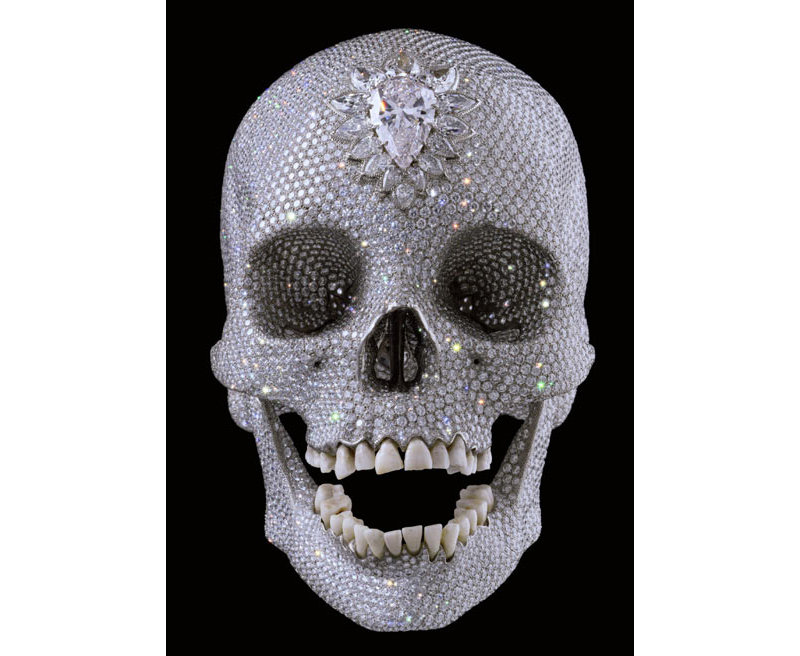For the Love of God(2007) Damien Hirst
Research Damien Hirst's work For the Love of God (2007) in order to answer the following questions;
1. Describe the work, giving details of the form and materials.
'For the love of God' created by Damien Hirst in 2007. It is a platinum cast of an actual 200-year-old male adult human skull that Hirst picked up in a London taxidermy shop. He created the Expensive head infrastructure, then he used 8,601 diamonds weighing more than 1100 carats like he was spreading seeds on a Chia Pet. The single large diamond in the middle of the forehead is reportedly worth $4.2 million alone. Set in the middle of the forehead and breaking up the even pattern of
smaller jewels that follow the exact contours of the bone is a large,
pear-shaped diamond surrounded by smaller diamond petals.At the end of work Hirst took the real human teeth from the original skull and set them in the jawbones of the skull.
2. What does the work mean? What is Damien Hirst communicating in the work?
The Diamond skull never shows in the art history, it is a fresh eye-catching work which represents a traditional "memento mori", an object that speaks of the transience of human existence. According to Rudi Fuchs: "The skull is supernatural, almost heavenly. Proclaims victory over decay. At the same time represents death as something infinitely more relentless. Compared to the tearful sadness of a vanitas scene, the Skull of Diamonds is pure glory. " That's how communicated to Damien Hirst, he proved how human existence with gorgeous life, just like he said:"I wouldn't mind if it happened to my skull after my death." http://www.artquotes.net/masters/hirst/for-the-love-of-god.htm
The Diamond skull never shows in the art history, it is a fresh eye-catching work which represents a traditional "memento mori", an object that speaks of the transience of human existence. According to Rudi Fuchs: "The skull is supernatural, almost heavenly. Proclaims victory over decay. At the same time represents death as something infinitely more relentless. Compared to the tearful sadness of a vanitas scene, the Skull of Diamonds is pure glory. " That's how communicated to Damien Hirst, he proved how human existence with gorgeous life, just like he said:"I wouldn't mind if it happened to my skull after my death." http://www.artquotes.net/masters/hirst/for-the-love-of-god.htm
3. How does Hirst's diamond encrusted skull relate to Mercantilism and to conspicuous consumption?

 Mercantilism advocated that a nation should export more than it imported and
accumulate bullion (especially gold) to make up the difference. The
exportation of finished goods was favored over extractive industries. "For the Love of God" is one of the most controversial works by the
artist and was sold to a group of collectors in 2007 for $100 million. The skull contains more than three times the diamonds than the British
Imperial State Crown. When the skull was shown at the White Cube gallery
in London in 2007 in its own room, dimly lit with carefully placed
lights, people were allowed in by ticket in groups of ten for five
minutes at a time.
Mercantilism advocated that a nation should export more than it imported and
accumulate bullion (especially gold) to make up the difference. The
exportation of finished goods was favored over extractive industries. "For the Love of God" is one of the most controversial works by the
artist and was sold to a group of collectors in 2007 for $100 million. The skull contains more than three times the diamonds than the British
Imperial State Crown. When the skull was shown at the White Cube gallery
in London in 2007 in its own room, dimly lit with carefully placed
lights, people were allowed in by ticket in groups of ten for five
minutes at a time.
http://www.escapeintolife.com/essays/for-the-love-of-god/
4. How much did the work cost, and how much was it sold for, and who bought it?
The skull cost $20 million to make, including diamonds and fabrication. London’s White Cube gallery announced that British artist Damien Hirst diamond-encrusted skull sold for $100 million dollars, a record price for work sold by a living artist.
http://www.artknowledgenews.com/Damien_Hirst_For_The_Love_Of_God.html
5. What are some of the differing opinions of the journalists in the newspaper and blog articles?
What did they think of the work?
Damien Hirst is not the world's greatest current artist. But he's probably its savviest. Hirst explores the uncertainty at the core of human experience; love, life, death, loyalty and betrayal through unexpected and unconventional media. art historian Rudi Fuchs has said, “The skull is out of this world, celestial almost. … At the same time it represents death as something infinitely more relentless. Compared to the tearful sadness of a vanitas scene, the diamond skull is glory itself.”
6. Based on your research, what is your opinion of the work, as an object or a work of art.
I strongly agree "For the Love of God"as a work of perfect art. Due to skull's mysterious no body created this form before, until Hirst broke the rule. I think most people would agree that their skulls are a priceless asset. But what artist Damien Hirst has done to the following skull has actually made a nondescript skull into one of the most expensive pieces of art ever. He created by cost $20 millions after he could gain more and more. That's a really good expel for me to known what is Mercantilism about and how he can be so succeed.











